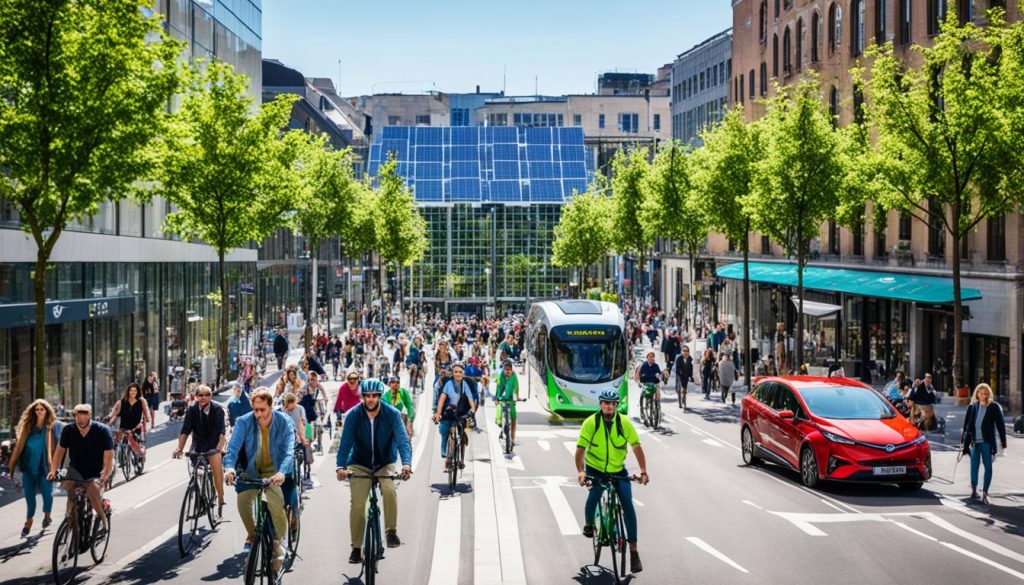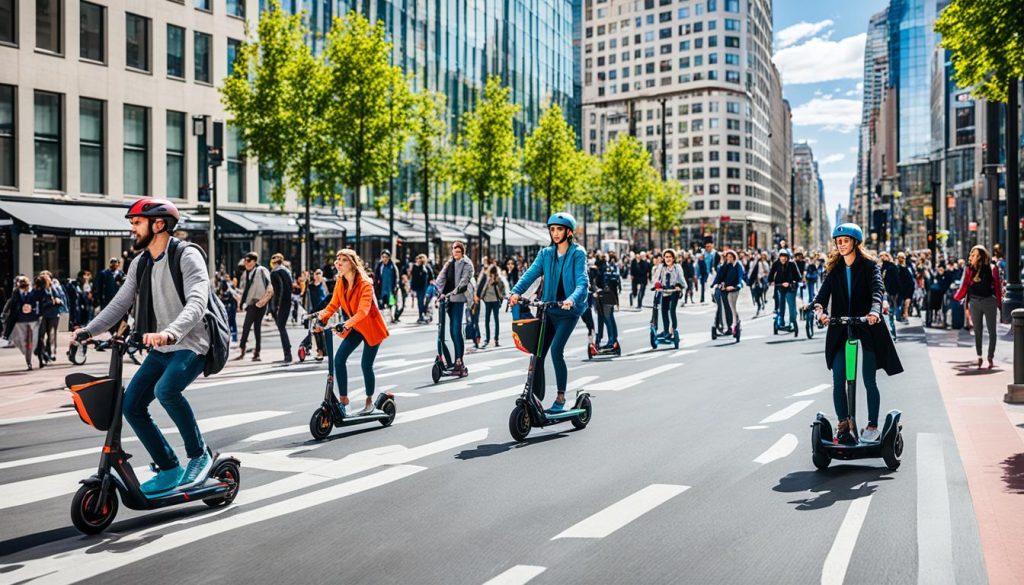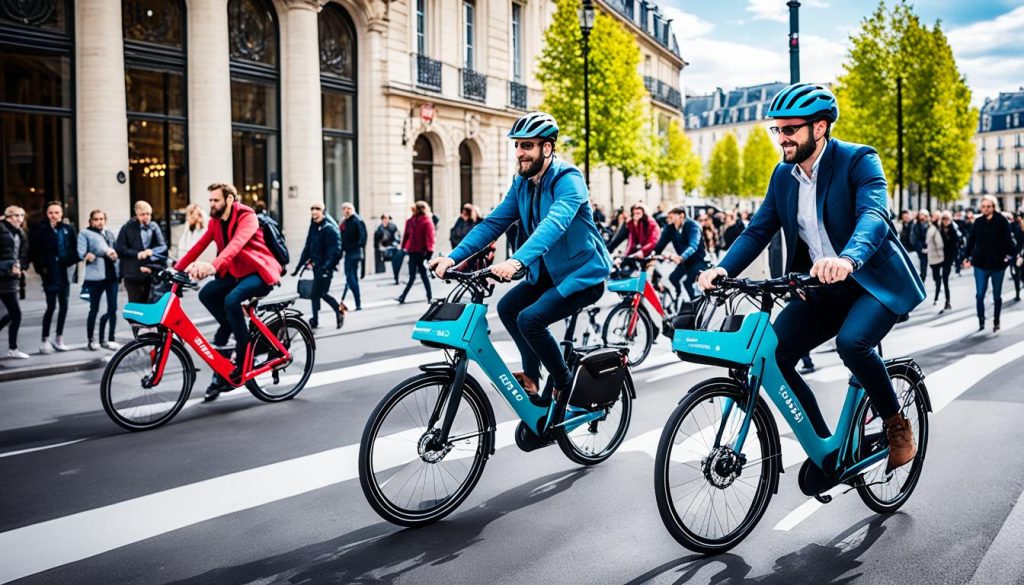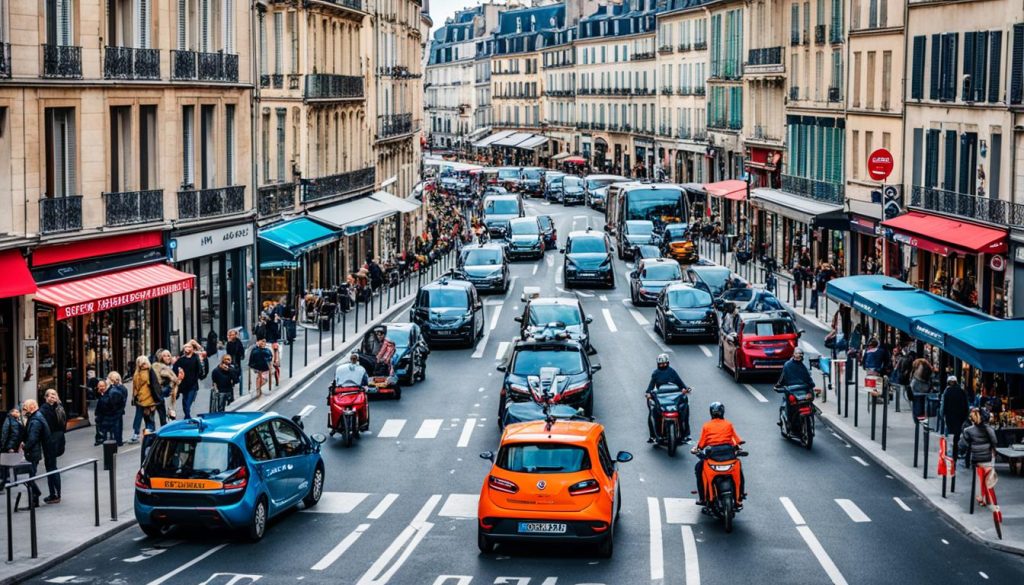The French transport scene is changing quickly. It’s seeing big shifts due to new technology and a push for sustainability. Upgrades to infrastructure and more electric vehicles are just the start. Digital solutions and green transport are becoming key.
These changes make travel different and open doors for new ideas and teamwork.
Key Takeaways:
- The French transport scene is experiencing rapid evolution and transformation.
- Infrastructure upgrades and expansion projects are improving connectivity and accessibility.
- The rise of electric mobility is revolutionizing the way people commute and reducing environmental impact.
- There is a growing focus on sustainable transport solutions to address climate change and promote greener alternatives.
- Digital technology integration is enhancing passenger experience, efficiency, and safety in the transport sector.
Infrastructure Upgrades and Expansion
Improvements and growth are key in the French transport world. France spends a lot on updating and making its transport better for everyone. These changes aim to make travel easier and options more sustainable for people and goods.
Building new roads is a big focus. France wants to handle more cars and reduce traffic jams by expanding its roadways. These efforts make travel safer and boost the economy by easing the movement of products.
The country is also investing in its railways, including new high-speed lines like the TGV. This makes long trips quicker and offers a greener way to travel over flying. It leads to a more sustainable transport system.
Updating and growing airports is another priority. Major cities across France are improving their airports to handle more travellers. This makes flying smoother and boosts connections within France and abroad.
France is committed to making its transport better through various projects. These include new bridges and smarter transport systems using digital tech. It’s all about making journeys better and more efficient.
Investment in Sustainable Infrastructure
France is not just making its transport bigger; it’s also making it greener. It’s adding things like electric car chargers on highways and using clean energy at transport hubs. This shift towards sustainability is in line with France’s green goals.
This eco-friendly focus is part of France’s plan to cut emissions and promote green energy. By adding sustainable features to its infrastructure, France is working towards a cleaner transport network. This helps reduce the use of oil and gas.
With its projects, France is aiming to meet its people’s future travel needs while focusing on eco-friendliness. These efforts improve travel ways and lead to a greener, more connected future.
Rise of Electric Mobility
France’s transport world is changing fast, thanks to electric mobility. The push for cleaner, sustainable transport has made electric vehicles (EVs) a hit among people and policymakers. We’ll dive into the latest trends and shifts in France’s electric transport.
Increase in Charging Infrastructure
More charging stations have helped electric mobility grow. EV owners find it simpler to charge their cars. The French government and businesses have worked together to put more charging spots in cities, parking spaces, and highways.
This move towards better charging facilities has made people less worried about battery life. It shows that EVs can be both useful and easy-to-use ways to travel.
Government Initiatives
The French government really backs electric mobility. They’ve introduced plans and incentives to encourage people to choose EVs. Significant efforts include eco-bonuses and conversion benefits, helping lower the cost of getting an electric vehicle.
They’re also aiming to reduce the use of petrol-driven vehicles. And they want more electric public transport. This supports the shift to electric mobility across France.
Adoption of Electric Transportation Solutions
Electric mobility isn’t just about cars. It includes electric buses, scooters, and bikes too. These options have made France’s transport cleaner and quieter.
They help cut down on pollution and make city air fresher. With ongoing improvements in laws and support structures, electric transport is becoming more integrated into everyday life.
| Benefits of Renewable Energy | Challenges of Renewable Energy |
|---|---|
|
|
Shift to Sustainable Transport

France is making big changes to go green, focusing on eco-friendly ways to travel. It’s all about cutting down pollution and making life better for everyone. This switch helps keep the air clean and improves living standards.
Public transport is key to this green shift. France is spending more money to make buses and trains better. They’re making it easier and more reliable to use public transport. This has led to fewer cars on the road and less traffic jams.
Cycling is also getting a big push as a green choice. The government is building bike lanes and promoting bike-sharing schemes. Safe places to park bikes are part of the plan. Choosing to bike more can lead to a healthier life and less pollution.
Moreover, France is exploring new clean fuels and pushing for electric cars. They’re offering money savings and tax breaks to encourage people to buy electric vehicles (EVs). Thanks to these efforts, more EVs are being used all over France.
By focusing on these sustainable transport options, France aims to lower its environmental impact. These steps don’t just help the planet; they also make communities stronger and healthier.
Integration of Digital Technology
The French transport is changing fast with digital tech. Digital innovations make transport smarter and more efficient. This revolutionizes how people move around the country.
Smart transportation systems are a big deal in digital tech. They use data and real-time info to make traffic flow better. They reduce jams and make transport more efficient. With smart algorithms and sensors, officials can make decisions based on data. This improves commuters’ journeys.
Ride-sharing platforms, like Uber and BlaBlaCar, are big in France thanks to digital tech. They offer cheaper and convenient options compared to traditional transport. These platforms use apps and GPS to link passengers with drivers. This way, people can share rides and cut down on pollution. Such innovations have changed travel ways and helped reduce jams and pollution.
Data analysis is key to improving France’s transport. It involves analyzing data from sensors, cameras, and mobiles. This lets transport authorities understand passenger habits, traffic flow, and how well infrastructure is used. This intel helps improve routes and manage resources better. It leads to a smoother and greener transport network.
Digital technology is remaking French transport, making it more connected and efficient. By adopting these new solutions, France is leading in innovative and green transport. As digital tech grows, so do the ways to transform transport. France stands at the edge of this digital change.
| Advantages of Integration of Digital Technology |
|---|
| Enhanced traffic flow optimization |
| Reduction in congestion and travel time |
| Improved passenger experience |
| Cost-effective and eco-friendly ride-sharing options |
| Efficient resource allocation |
Emphasis on Public Transport
In recent years, France has focused more on improving its public transport system. They know public transport helps cut down on traffic, supports sustainability, and makes getting around easier. So, the government and local authorities have been putting money into various projects.
New bus and tram systems are popping up in big cities. These are meant to make travel easy and less dependent on cars. With their own lanes and traffic light priorities, these services are both quick and reliable.
Also, France is improving its intercity train connections. With the expansion of the high-speed TGV network, fast and comfortable journeys connect major areas. This not only enhances trips within France but boosts international travel too.
France is introducing integrated ticketing systems. This lets passengers move between different transport types with just one ticket or card. It makes travel smoother and encourages more people to use public transport.
France’s push for sustainable transport includes more than new trains and buses. It supports car-sharing, bike-sharing, and walking-friendly city designs. These actions help move towards greener, healthier cities.
Advantages of Public Transport
Public transport brings many benefits to both people and the planet. Here are some major positives:
- It reduces traffic jams, which cuts down commute times and cleans the air.
- Public transport saves money compared to the costs of owning a car.
- It makes travel easy for everyone, including those with disabilities.
- Using public transport helps lower harmful gas emissions, fighting climate change.
- It also builds community, as it brings different people together.
| Advantages | Public Transport | Private Vehicles |
|---|---|---|
| Cost | More affordable, especially for regular commuters | Higher expenses on fuel, maintenance, and parking |
| Environmental Impact | Lower greenhouse gas emissions | Higher carbon footprint |
| Time Efficiency | Dedicated lanes and priority at traffic signals | Subject to traffic congestion and delays |
| Accessibility | Provides options for individuals with disabilities | May pose challenges for individuals with mobility limitations |
| Social Interaction | Promotes interactions between individuals | Isolating, especially during solo commutes |
By focusing on public transport, France is creating a transport system that’s greener, more efficient, and welcoming for everyone. With these updates and innovative ideas, France is leading the way for other nations wanting to upgrade their transport systems.
The Rise of Micromobility

In recent years, small vehicles like e-scooters and bikes have changed city travel. Micromobility means using these light, compact vehicles for short trips.
The Popularity of E-scooters
E-scooters are becoming a favourite in France. People enjoy their simplicity and green benefits for quick trips. They’re ideal for the last leg of a commute.
Impact on Urban Mobility
E-scooters and bikes make city travel better in France. They cut down on traffic and pollution. Plus, they’re cheaper and faster for getting around.
Regulations and Challenges
With micromobility’s growth, France had to set safety rules. There are limits on speed and where you can ride and park. But finding the right mix of freedom and control is tough.
| Benefits of Micromobility | Challenges of Micromobility |
|---|---|
| Reduces traffic congestion | Ensuring rider and pedestrian safety |
| Improves air quality | Managing parking and distribution |
| Enhances accessibility | Maintaining infrastructure |
The Future of Micromobility
Micromobility is on the rise globally, starting with France. As cities grow, so will the use of these small vehicles. They promise greener, more livable cities ahead.
Innovations in Freight Transport
Innovations in freight transport are changing how goods move across France. These changes help deliver goods faster, more efficiently, and in ways that harm the environment less. New technologies and practices, such as eco-friendly transport and smarter logistics, are leading this change.
Logistics Optimization
Logistics optimization is a main innovation area in freight transport. By using data analytics and artificial intelligence, companies make supply chains better. They improve planning, cut transport costs, and make loading more efficient. This does not just save time and money. It also cuts down on fuel use and reduces harmful emissions.
Eco-Friendly Delivery Methods
The move towards green delivery methods is growing in the freight sector. Electric and hybrid vehicles are replacing old diesel trucks. Also, there’s interest in natural gas and hydrogen as cleaner fuels. Innovations like electric bikes and drones are making deliveries faster and less polluting, especially in busy cities.
Automation and Robotics
Automation and robotics are making the freight sector more efficient while reducing the need for human labour. Robots in warehouses make sorting and picking orders faster and more precise. Testing of self-driving vehicles promises safer and more effective logistics. These changes boost productivity and make deliveries safer by lowering the chance of human mistakes.
The Future of Freight Transport
The future of freight transport in France looks very promising. With ongoing progress in technology and a focus on sustainability, innovative solutions are being developed. These advancements ensure that the freight transport sector can meet the future needs of our constantly changing world.
Changing Travel Patterns
The way people travel in France is changing a lot. More people now work from home or have flexible hours. This change affects when and how they travel.
There are fewer trips to the office now. Many choose to work remotely or use co-working spaces near their homes. This spreads out the usual busy travel times.
Ride-sharing and car-sharing services are also becoming more popular. Instead of owning a car, people are using these shared transport options. This reduces the need for owning personal cars.
The Impact on Public Transport
These new travel habits have a big influence on public transport. With fewer people travelling during rush hours, buses and trains can adjust their schedules. They can focus on providing better service when it’s not so busy.
Shared mobility services can work well with public transport, too. Apps that combine these services make it easy for people to travel. They can switch between different transport modes easily.
This change poses challenges for those planning city transport. They need to create flexible solutions that cater to these varying needs. They might use advanced technology to improve travel for everyone.
The Future of Travel
As travel trends keep evolving, it’s important for transport sectors to stay ahead. By understanding these new habits, they can create better transport systems. Partnerships and smart planning will be key to their success.
Looking forward, transport in France aims to be more connected and green. Embracing these changes can make travel better and more environmentally friendly for everyone.
Integration of Mobility as a Service (MaaS)

Mobility as a Service (MaaS) is changing how people get around in France. It combines buses, trains, taxis, and rideshares on one platform. This way, it makes getting from place to place smooth and easy.
With MaaS, you can plan and book trips with one app or website. You can choose the best way to travel, check times, and book tickets all in one spot. This makes it simpler for people to move around cities and get to where they need to go fast.
MaaS isn’t just handy. It helps cut down on traffic jams and pollution too. It pushes people to use public transport and shared rides instead of their own cars. This is part of France’s plan to look after the planet and fight climate change.
But, making MaaS work everywhere comes with hurdles. It requires different transport companies to work together. They must tackle tech issues, keep data safe, and get people to try new ways of traveling.
The Role of Public-Private Partnerships
Public-private partnerships are vital for MaaS in France. They bring together the government, transport companies, tech firms, and others. Together, they build a system that lets MaaS grow.
The government sets rules and offers perks to get companies on board. They help share information between services, making sure everything works together smoothly. Private businesses use their tech and know-how to make MaaS user-friendly and innovative.
Thanks to these partnerships, MaaS is becoming a norm in France. It’s changing travel for the better, leading to a greener, more efficient way to move around.
| Benefits of MaaS: | Challenges of MaaS: |
|---|---|
|
|
Regulatory Changes and Policies
The French transport scene is changing fast. Government rules and policies are guiding its future towards sustainability. Efforts to cut carbon emissions, make the air cleaner, and push for innovation have changed transport in many ways.
Emission Standards
France is making vehicles cleaner by setting tough emission standards. The country follows Euro 6 rules. These limit pollution from cars, bikes, and lorries. Such laws push for electric and hybrid vehicles, making companies think more about green options.
Congestion Charging
To tackle traffic jams and cut pollution, cities in France have congestion charges. These charges apply to vehicles entering busy areas at peak times. This makes people consider using public transport or other travel methods. Money from these fees helps to improve public transport systems.
Promotion of Sustainable Transport Options
The government supports green travel choices through incentives and funding. There’s money help for buying electric vehicles and setting up charge points. They also fund bike paths. Plus, sharing rides and carpooling get a boost to lower the count of cars with just one person.
These efforts aren’t just about the environment. They also work to create a smarter, fairer transport network for everyone. By focusing on green travel and promoting change in how we move, France aims to meet its environmental and transport targets.
Role of Public-Private Partnerships
Public-private partnerships (PPPs) shape the French transport field. They are collaborations between government bodies and businesses. They play a key role in bringing new ideas, improving infrastructure, and providing sustainable transport solutions.
Benefits of Public-Private Partnerships
Public-private partnerships combine the strengths of the public and private sectors. This allows for the execution of big and important transport projects. Such projects might be too difficult to achieve by the government or companies alone.
The advantages of public-private partnerships in France’s transport include:
- Efficiency: PPPs make projects move faster by cutting through red tape. This makes delivering transport infrastructure quicker.
- Financial Resources: Private firms invest a lot of money in transport projects. This takes some financial pressure off the government.
- Innovation: Working with businesses brings in new ideas, technology, and new ways of thinking to transport.
- Risk Sharing: In PPPs, both the government and businesses share risks and duties. This ensures both are actively involved in managing projects.
- Long-Term Sustainability: PPPs help develop transport solutions that are good for the environment. This includes electric vehicles and greener infrastructure.
Successful Examples of Public-Private Partnerships in France
France is known for several successful PPP projects in transport:
- The Lyon-Turin Rail Link: This high-speed rail line connects France and Italy. It is a great example of how government and private sectors can work together. It has improved connectivity and encouraged greener travel.
- The Grand Paris Express: Thanks to private companies working with the government, Paris is getting a huge new metro system. It will boost urban travel and economic growth.
- The Bordeaux Tramway: The local government and private groups have expanded and updated Bordeaux’s tram system. This has greatly improved travel for people living in and visiting the city.
These projects show how public-private partnerships can lead to innovative and sustainable transport solutions.
The Future of Public-Private Partnerships in French Transport
As transport in France changes, public-private partnerships will become more important. They will be crucial for embracing new technology, promoting green transport, and meeting new travel demands.
By working together, the public and private sectors can tackle future challenges. This will ensure a strong and efficient transport system for everyone in France and its visitors.
| Benefits of Public-Private Partnerships |
|---|
| Efficiency |
| Financial Resources |
| Innovation |
| Risk Sharing |
| Long-Term Sustainability |
Challenges Ahead
The French transport scene has seen big changes and growth recently. But, it faces some challenges as it grows. Overcoming these challenges is key to making the transport system in France sustainable and efficient.
1. Funding Constraints
Funding is a big issue for French transport. There’s a need for more investment in infrastructure, network expansion, and new technologies. The government and transport bodies should look into new financing ways and partner with private companies to fill this funding gap.
2. Infrastructural Bottlenecks
More people need transport services, leading to infrastructural bottlenecks. To deal with this, we must find and fix these bottlenecks. This could mean making roads, railways, and public transport better to handle more passengers and reduce congestion.
3. Need for Continued Innovation
Innovation is crucial to meet new demands and expectations. The transport industry has to keep up with new technologies and trends. This includes adopting electric mobility, supporting smart cities, and using advanced data to make operations more efficient and improve services.
4. Transition to Sustainable Transportation
The move to sustainable transport is essential but challenging. Promoting electric vehicles and expanding cycling infrastructure helps cut carbon emissions. But, we must build enough charging points and manage the move away from fossil fuels carefully.
5. Evolving Regulatory Landscape
Transport laws are always changing, with new rules for safety, sustainability, and innovation. Companies in transport must keep up with these laws and work closely with regulators. This means following the latest best practices and standards.
6. Changing Mobility Patterns
How we move is changing due to urban growth, demographic changes, and the sharing economy. Transport services need to adapt, offering more flexible options, integrated tickets, and smooth multi-modal journeys. Staying in tune with these changes is vital for serving passengers well.
7. Enhancing Collaboration
To face future challenges, the transport sector needs better collaboration. This means more partnership between public and private sectors, cooperation across different transport methods, and working with communities for inclusive and sustainable solutions.
By tackling these challenges, the French transport sector can keep transforming and meeting the needs of our changing society. Overcoming these issues will build a strong, future-ready transport system. It will support economic growth, enhance lives, and help the environment.
International Collaboration
The rapid change in France’s transport scene owes much to global teamwork. Nations are joining forces to create better, sustainable transport systems. This need for shared knowledge and cooperation is crucial.
Cross-border transport projects show how valuable international teamwork is. Countries collaborate to make travel between them smoother. Projects like the Eurostar, which links France and the UK, boost economic growth and improve connections.
The Benefits of International Collaboration
Working together internationally brings many positives. It lets countries share smart ideas and avoid mistakes. This way, transport systems around the world get better.
It also means countries can use each other’s strengths. Through joint projects, they come up with new technologies. This makes transport both more efficient and sustainable. Through these projects, experts from different countries meet, enhancing cultural ties and global teamwork.
Initiatives Driving International Collaboration
The International Transport Forum (ITF) is a key player in promoting global transport talks. It’s a group where countries discuss transport issues. The ITF helps share knowledge and sparks innovations.
The European Union (EU) also encourages teamwork in transport. Through its programmes, it supports collaboration and funding for better infrastructure. These efforts help member states work together for a greener, more connected Europe.
Working together globally is essential to tackle big challenges like climate change. By sharing ideas, countries can come up with smart solutions. This teamwork helps make transport systems more eco-friendly and efficient.
Future Outlook for the French Transport Scene
The French transport scene is set for an exciting future. It’s leading in transportation innovation with rapid infrastructure changes, electric mobility, and sustainable transport. The use of digital technology and a focus on public transport are making the system more efficient and connected.
Micromobility and freight transport innovations offer new choices for everyone. The way people travel in cities is changing thanks to Mobility as a Service (MaaS). Clean, sustainable transport is being pushed forward by new policies and regulations.
Looking ahead, the transport scene in France will keep evolving to meet new challenges. Partnerships between public and private sectors will boost innovation and investments. France will also benefit from international collaborations to find effective solutions.
The outlook for France’s transport sector is very positive. By taking advantage of tech, sustainable methods, and teamwork, France aims to build a transport system that’s green, efficient, and open to all.
















